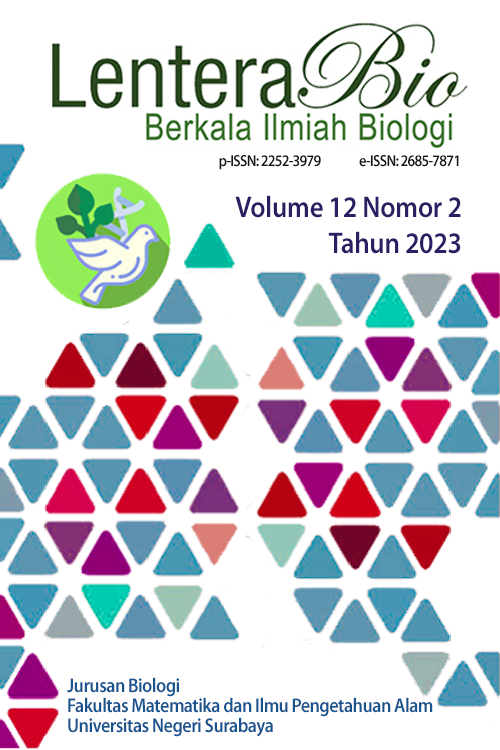Pollen Morphology and Pollen Viability Analysis Variations from Hibiscus rosa-sinensis Cultivars
DOI:
https://doi.org/10.26740/lenterabio.v12n2.p123-131Keywords:
Biology, Plant Development Structures, PalynologyAbstract
Hibiscus rosa-sinensis or the so-called Shoe flower is known as an example of genetic diversity. This is due to the variety of flower petal colors produced. This study aimed to determine the morphology and viability of Hibiscus rosa-sinensis. The exploration study resulted in five cultivars of Hibiscus rosa-sinensis: red-colored Hibiscus, white-colored Hibiscus, pink-colored Hibiscus, Hibiscus rosa-sinensis ‘Double’, and Hibiscus rosa-sinensis ‘Variegata’ were found. Pollen morphology analysis and viability observation were conducted at the Plant Structure and Development Laboratory at the Universitas Negeri Surabaya. Observed characteristics were units, polarity, shape, exine ornamentation, aperture, polar/equatorial index, total spine, spine length, and spine distance. The result from pollen morphology analysis is that there are some differences such as polar/equator index, amount of spine, spine length, and spine distance in every variant found. Pollen viability was observed with two methods, pollen germination and pollen staining with aniline blue. The result from the pollen germination method was pollen tube germinated after 2-3 days, while the staining method resulted in Hibiscus rosa-sinensis pollen being viable with the highest viability percentage found at the red-colored Hibiscus with 44% and the lowest viability percentage were found at the pink-colored Hibiscus with 7%.
Downloads
Published
How to Cite
Issue
Section
License
Copyright (c) 2023 LenteraBio : Berkala Ilmiah Biologi

This work is licensed under a Creative Commons Attribution-NonCommercial 4.0 International License.
Hak Cipta (c) LenteraBio: Berkala Ilmiah Biologi
Karya ini dilisensikan di bawah Lisensi Internasional Creative Commons Attribution-NonCommercial 4.0.
Pemberitahuan Hak Cipta.
Hak cipta dari artikel yang diterima untuk diterbitkan akan diberikan kepada jurnal sebagai penerbit jurnal. Hak cipta yang dimaksud meliputi hak untuk menerbitkan artikel dalam berbagai bentuk (termasuk cetak ulang). Jurnal mempertahankan hak penerbitan atas artikel yang diterbitkan.
 Abstract views: 6684
,
Abstract views: 6684
, PDF Downloads: 20804
PDF Downloads: 20804











